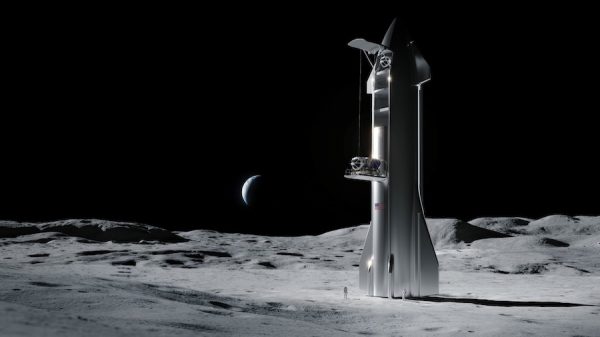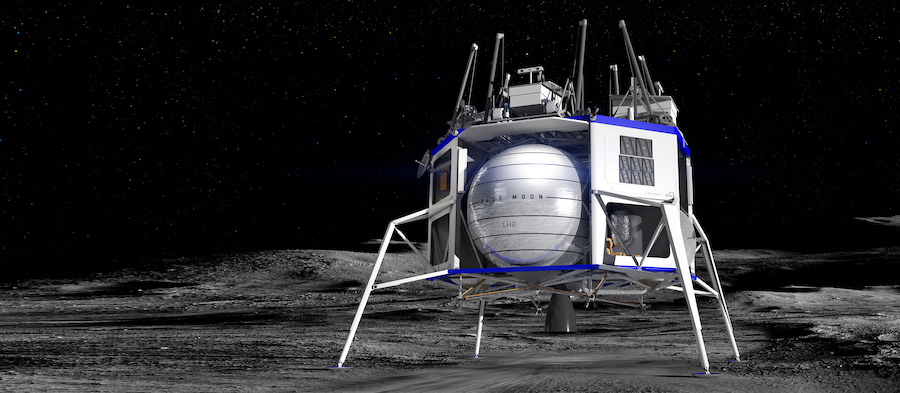SpaceX offering Starship to NASA for lunar landing missions – Spaceflight Now

SpaceX is eligible to propose using its next-generation Starship vehicle to carry NASA robotic science payloads to the lunar surface, the U.S. space agency announced Monday, on missions that could precede future Starship flights with people on-board.
SpaceX is one of five companies NASA selected Monday to join a roster of commercial transportation providers to deliver scientific instruments and technology demonstration packages to the moon through the Commercial Lunar Payload Services, or CLPS, program.
“For CLPS, we offered the Starship and Super Heavy launch capability,” said Gwynne Shotwell, SpaceX’s president and chief operating officer. “That capability far exceeds the mass that CLPS was looking for, but we think that brings pretty extraordinary capability to NASA, both for the CLPS program and others. We can bring about 100 metric tons to the moon, and certainly return more.”
NASA requires the CLPS providers to be capable of delivering at least 22 pounds, or 10 kilograms, of payload mass to the moon.
SpaceX’s Starship and Super Heavy vehicles are the two main pieces of the company’s next-generation launch system. The combined launcher will stand 387 feet (118 meters) tall and measure 50 percent wider than the fuselage of a Boeing 747 jumbo jet.
Shotwell said SpaceX, founded and led by billionaire Elon Musk, aims to land a Starship on the moon in 2022. She said robotic Starship missions, such as flights contracted through NASA’s CLPS program, will pave the way for crewed Starship launches.
The Starship was “originally conceived to carry people,” Shotwell said, similar to the way SpaceX developed a cargo variant of the Dragon capsule before designing and building an upgraded human-rated Dragon spacecraft. “We’re leveraging NASA initially for cargo and science, so I think it’s a nice stepping stone and a nice path to getting comfortable with the technology … so that it’s reliable enough to put people on-board.”
SpaceX is building prototypes of the Starship vehicle in Texas and Florida, and atmospheric test flights could begin within weeks or months. The Starship will serve as a second stage on top of the Super Heavy booster, which SpaceX plans to build and test after the Starship.
The Super Heavy and Starship, both designed for reuse, will be powered by SpaceX’s methane-fueled Raptor rocket engines. SpaceX intends to land the Super Heavy on the ground similar to the way the company lands Falcon rocket boosters. The Starship will be similarly capable of vertical landings on Earth, or on other planetary surfaces.
“Starship, right now, (for) the early missions, we’re very focused on cargo, both satellite delivery to orbit, science delivery to the surface of the moon, m cargo and science to the surface of Mars,” she said. “Then we’ll be looking at some crew flights.”
The other companies selected by NASA to join the agency’s list of CLPS providers Monday were Blue Origin, Ceres Robotics, Sierra Nevada Corp. and Tyvak Nano-Satellite Systems. They join Astrobotic, Deep Space Systems, Draper, Firefly Aerospace, Intuitive Machines, Lockheed Martin, Masten Space Systems, Moon Express and Orbit Beyond, the nine companies selected as CLPS providers last year.
“We have a need and saw a need to bring on some additional providers that had enhanced lander capabilities,” said Steve Clarke, deputy associate administrator for exploration in NASA’s Science Mission Directorate. “This is based on … the agency’s objectives to get to the moon as soon as possible.”
Clarke said NASA received eight proposals to join the roster of CLPS providers. The agency picked five companies to “on-ramp” to the CLPS program.
“All of them bring to the table different strengths and different ideas, and that’s what we want to bring as NASA continues to lean forward and use commercial services to explore the moon,” Clarke said. “We want as many … diverse ideas as we can on the table. So we look forward to hearing reading and assessing those ideas when we put out these task orders.”
Blue Origin’s Blue Moon cargo lander can deliver nearly 8,000 pounds, or 3.6 metric tons, of payload equipment to the lunar surface. Brent Sherwood, Blue Origin’s senior vice president of advanced development programs, said Monday that the Blue Moon lander is designed to survive the two-week-long lunar night and can launch on the company’s New Glenn rocket.
John Roth, vice president of business development at Sierra Nevada’s space systems division, said the company will modify existing small satellite platforms for lunar lander missions to haul lighter payloads to the moon. Technologies developed for Sierra Nevada’s Dream Chaser space station cargo transporter could be used to carry heavier equipment to the lunar surface, Roth said.
The other companies’ initial lander designs are capable of carrying smaller payload packages to the moon.
Tyvak Nano-Satellite Systems specializes in building CubeSats and other small satellites, and Ceres Robotics is a Silicon Valley startup founded in 2017 to develop vehicles to explore the surfaces of the moon, Mars, asteroids and other planetary bodies.

NASA started the CLPS program to purchase unpiloted rides to the moon for the agency’s scientific payloads aboard privately-owned spacecraft. The missions are precursors for future human expeditions to the moon planned in NASA’s Artemis program, which aims to return astronauts to the lunar surface by the end of 2024.
The 14 companies now part of the CLPS program are eligible to compete for NASA contracts to ferry scientific instruments to the moon. NASA is releasing a series of task orders for specific mission objectives, and the companies can submit bids for rights to conduct the missions.
“The services we are buying are buying, or are procuring, are end-to-end,” Clarke said. “The companies that we award task orders are responsible for securing a ride on a launch vehicle, and of course, delivering our instruments or payloads to the surface, and then actually enabling us to operate those instruments or payloads on the surface of the moon.”
NASA selected three companies — Astrobotic, Intuitive Machines and Orbit Beyond — for the first CLPS task orders in May. NASA terminated the task order with Orbit Beyond in July, but the company remains eligible for future CLPS contracts.
Astrobotic and Intuitive Machines remain on contract with NASA to deliver NASA science instruments to the moon’s surface in July 2021.
None of NASA’s 14 CLPS providers have a lunar lander currently in operation.
Firefly Aerospace’s CLPS proposal includes plans to build a U.S. version of the Israeli Beresheet lander, a privately-funded mission that crashed on the moon during a landing attempt in April.
In addition to its role in providing delivery services for NASA science payloads, the CLPS program will advance lunar landing technologies that could be useful on a future human-rated lander, according to NASA officials.
It’s also an experiment in the commercial procurement of lunar transportation services, an example NASA is following in the multibillion-dollar procurement of a human-rated lander for the Artemis program.
Blue Origin submitted a lander proposal derived from the Blue Moon spacecraft in response to NASA’s Human Landing System solicitation earlier this month. Boeing also confirmed it bid for an HLS contract.
Other companies, including SpaceX, are also expected to have submitted human-rated lander proposals.
Email the author.
Follow Stephen Clark on Twitter: @StephenClark1.






